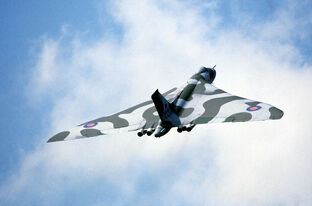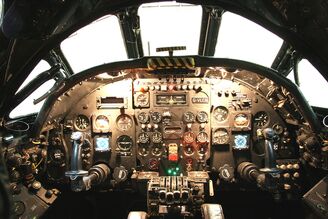No edit summary |
m (Remove some templates. interwiki links, delink non military terms, add link to Wikipedia and cleanup) |
||
| Line 1: | Line 1: | ||
| − | '''[[File: |
+ | '''[[File:Avro Vulcan.jpg|thumb|left|312px|Avro Vulcan]]Avro Vulcan''' is a bomber strategic autonomy manufactured in large England by Avro. |
Easily identified by its delta wings, was one of three models of so-called magic trio Royal Air Force the ''"V Bombers"'', On which rested longer nuclear deterrence of England. Outstanding tactical bomber at low altitude (Version B.2). Not carrying defensive armament. |
Easily identified by its delta wings, was one of three models of so-called magic trio Royal Air Force the ''"V Bombers"'', On which rested longer nuclear deterrence of England. Outstanding tactical bomber at low altitude (Version B.2). Not carrying defensive armament. |
||
| Line 7: | Line 7: | ||
The Avro Vulcan was a British delta-wing subsonic bomber, operated by the Royal Air Force from 1953 until 1984. The Vulcan was part of the RAF's V bomber force, which fulfilled the role of nuclear deterrence against the Soviet Union during the Cold War. |
The Avro Vulcan was a British delta-wing subsonic bomber, operated by the Royal Air Force from 1953 until 1984. The Vulcan was part of the RAF's V bomber force, which fulfilled the role of nuclear deterrence against the Soviet Union during the Cold War. |
||
| − | Although the primary weapon for the Vulcan was nuclear, Vulcans could carry up to 21 x 1000 |
+ | Although the primary weapon for the Vulcan was nuclear, Vulcans could carry up to 21 x 1000 lb (454 kg) bombs in a secondary role. The only combat missions involving the Vulcan took place in the 1982 Falklands War with Argentina, when a number of Vulcans flew the 3,380 nautical miles (6300 km) from Ascension Island to Stanley to bomb the occupied airfield there with[[File:Xh558cockpitlarge.jpg|thumb|328px|Vulcan's Cockpit]] conventional bombs in Operation Black Buck. By this date the number of Victors available for air-to-air refueling was extremely limited, so some Vulcan aircraft were adapted in just 50 days to fulfil that role during the conflict. Five Vulcans were chosen for the operation: their bomb bays were modified, the fuel systems replaced and the electronics updated. The first bombing mission was on April 30–May 1 and there were five further bombing missions. At the time these missions held the record for the world's longest distance raids. |
After the end of the Falklands War, the Vulcan was due to be withdrawn from RAF service. However, the disbandment of 57 Squadron and delays in the operational availability of the Tristar left a gap in the RAF's air to air refuelling capability. As an interim measure six Vulcan B.2s were converted into AAR tankers and commissioned into service with 50 Squadron from 1982 to 1984 |
After the end of the Falklands War, the Vulcan was due to be withdrawn from RAF service. However, the disbandment of 57 Squadron and delays in the operational availability of the Tristar left a gap in the RAF's air to air refuelling capability. As an interim measure six Vulcan B.2s were converted into AAR tankers and commissioned into service with 50 Squadron from 1982 to 1984 |
||
| Line 13: | Line 13: | ||
===General Characteristics=== |
===General Characteristics=== |
||
*'''Crew:''' 5 (pilot, co-pilot, AEO, Navigator Radar, Navigator Plotter) |
*'''Crew:''' 5 (pilot, co-pilot, AEO, Navigator Radar, Navigator Plotter) |
||
| − | *'''Length:''' 97 |
+ | *'''Length:''' 97 ft 1 in (29.59 m) |
| − | *'''Wingspan:''' 99 |
+ | *'''Wingspan:''' 99 ft 5 in (30.3 m) |
| − | *'''Height:''' 26 |
+ | *'''Height:''' 26 ft 6 in (8.0 m) |
| − | *'''Wing area:''' 3554 |
+ | *'''Wing area:''' 3554 ft² (330.2 m²) |
| − | *'''Empty weight:''' 83,573 |
+ | *'''Empty weight:''' 83,573 lb (including crew) (37,144 kg) |
| − | *'''Max takeoff weight:''' 170,000 |
+ | *'''Max takeoff weight:''' 170,000 lb (77,111 kg) |
| − | *'''Powerplant:''' 4× Bristol Olympus 101, or 102 or 104 turbojet, 11,000 |
+ | *'''Powerplant:''' 4× Bristol Olympus 101, or 102 or 104 turbojet, 11,000 lbf (49 kN) each |
===Performance=== |
===Performance=== |
||
| − | *'''Maximum speed:''' Mach 0.96 (607 |
+ | *'''Maximum speed:''' Mach 0.96 (607 mph (1,040 km/h)) at altitude |
| − | *'''Cruise speed:''' Mach 0.86 (567 miles per hour (912 |
+ | *'''Cruise speed:''' Mach 0.86 (567 miles per hour (912 km/h)) at 45,000 ft |
| − | *'''Range:''' 2,607 |
+ | *'''Range:''' 2,607 mi (4,171 km) |
| − | *'''Service ceiling:''' 55,000 |
+ | *'''Service ceiling:''' 55,000 ft (17,000 m) |
*'''Thrust/weight:''' 0.31 |
*'''Thrust/weight:''' 0.31 |
||
===Armament=== |
===Armament=== |
||
| ⚫ | |||
| − | |||
| ⚫ | |||
*1 x [[Blue Danube]] nuclear gravity bomb |
*1 x [[Blue Danube]] nuclear gravity bomb |
||
*1 x [[Violet Club]] 400-kiloton nuclear gravity bomb |
*1 x [[Violet Club]] 400-kiloton nuclear gravity bomb |
||
| Line 35: | Line 34: | ||
*1 x [[Red Beard]] nuclear gravity bomb |
*1 x [[Red Beard]] nuclear gravity bomb |
||
*1 x [[Blue Steel]] rocket-propelled 1.1 megaton nuclear stand-off missile |
*1 x [[Blue Steel]] rocket-propelled 1.1 megaton nuclear stand-off missile |
||
| − | ==See |
+ | ==See also== |
*[[Royal Air Force]] |
*[[Royal Air Force]] |
||
*[[Falklands War]] |
*[[Falklands War]] |
||
| Line 42: | Line 41: | ||
[[Category:Aircraft]] |
[[Category:Aircraft]] |
||
[[Category:Bomber Jets]] |
[[Category:Bomber Jets]] |
||
| + | |||
| + | {{Wikipedia|Avro Vulcan}} |
||
Latest revision as of 10:15, 19 December 2013

Avro Vulcan
Avro Vulcan is a bomber strategic autonomy manufactured in large England by Avro.
Easily identified by its delta wings, was one of three models of so-called magic trio Royal Air Force the "V Bombers", On which rested longer nuclear deterrence of England. Outstanding tactical bomber at low altitude (Version B.2). Not carrying defensive armament.
The prototype made its first test flight in 1952. But it was only in 1957 that version B.Mk1 began equipping RAF squadrons. The Vulcan left the service in the RAF in the early 80s, not before, however, to be held in 1982 his only real combat mission: raids extremely long with the code "Black Buck" When they bombed the runway and radar facilities at Port Stanley during the Falklands War. During one of these missions in June 3 of 1982, A Vulcan (No XM597) Suffers a breakdown hydraulic and can not perform the refueling. To not fall into the sea invades the Brazilian airspace being escorted by fighters Northrop F-5E Tiger II until Galeon AFB in Rio de Janeiro, where he makes an emergency landing, causing a diplomatic incident between Argentina, Brazil and Britain. After a few days retained, the plane is allowed to return to their base on the island of Acencion.
Description
The Avro Vulcan was a British delta-wing subsonic bomber, operated by the Royal Air Force from 1953 until 1984. The Vulcan was part of the RAF's V bomber force, which fulfilled the role of nuclear deterrence against the Soviet Union during the Cold War.
Although the primary weapon for the Vulcan was nuclear, Vulcans could carry up to 21 x 1000 lb (454 kg) bombs in a secondary role. The only combat missions involving the Vulcan took place in the 1982 Falklands War with Argentina, when a number of Vulcans flew the 3,380 nautical miles (6300 km) from Ascension Island to Stanley to bomb the occupied airfield there with

Vulcan's Cockpit
conventional bombs in Operation Black Buck. By this date the number of Victors available for air-to-air refueling was extremely limited, so some Vulcan aircraft were adapted in just 50 days to fulfil that role during the conflict. Five Vulcans were chosen for the operation: their bomb bays were modified, the fuel systems replaced and the electronics updated. The first bombing mission was on April 30–May 1 and there were five further bombing missions. At the time these missions held the record for the world's longest distance raids.
After the end of the Falklands War, the Vulcan was due to be withdrawn from RAF service. However, the disbandment of 57 Squadron and delays in the operational availability of the Tristar left a gap in the RAF's air to air refuelling capability. As an interim measure six Vulcan B.2s were converted into AAR tankers and commissioned into service with 50 Squadron from 1982 to 1984
Specifications
General Characteristics
- Crew: 5 (pilot, co-pilot, AEO, Navigator Radar, Navigator Plotter)
- Length: 97 ft 1 in (29.59 m)
- Wingspan: 99 ft 5 in (30.3 m)
- Height: 26 ft 6 in (8.0 m)
- Wing area: 3554 ft² (330.2 m²)
- Empty weight: 83,573 lb (including crew) (37,144 kg)
- Max takeoff weight: 170,000 lb (77,111 kg)
- Powerplant: 4× Bristol Olympus 101, or 102 or 104 turbojet, 11,000 lbf (49 kN) each
Performance
- Maximum speed: Mach 0.96 (607 mph (1,040 km/h)) at altitude
- Cruise speed: Mach 0.86 (567 miles per hour (912 km/h)) at 45,000 ft
- Range: 2,607 mi (4,171 km)
- Service ceiling: 55,000 ft (17,000 m)
- Thrust/weight: 0.31
Armament
- 21 x 1,000 pounds (454 kg) of conventional bombs
- 1 x Blue Danube nuclear gravity bomb
- 1 x Violet Club 400-kiloton nuclear gravity bomb
- 1 x Yellow Sun Mk.1 400-kiloton nuclear gravity bomb
- 1 x Yellow Sun Mk 2 400-kiloton nuclear gravity bomb
- 1 x Red Beard nuclear gravity bomb
- 1 x Blue Steel rocket-propelled 1.1 megaton nuclear stand-off missile
See also
The original article can be found at Avro Vulcan and the edit history here.